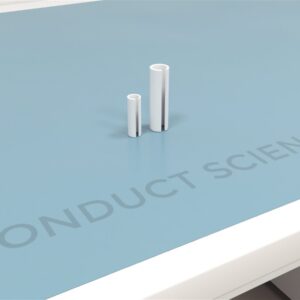$2,290.00
Pigs play a crucial role in TBI research due to their physiological similarities to humans. Sullivan et al. (2013) first described using open field behavior to identify a broad range of clinically relevant behaviors in piglets. These behaviors include sniffing the floor, walls, or a toy; running; walking; standing still for more than a second; lying down; moving the toy; and attempting to escape the test area.
The open field area is divided into nine zones, and the piglet’s snout position is recorded every 2 seconds. The MazeEngineers open field setup features a 1.2 m by 2.4 m pen with acrylic walls and a single toy (a 19 cm diameter blue ball), ensuring the piglet remains within the designated space.

MazeEngineers offers custom-built behavioral mazes at no extra cost—designed to fit your exact research needs. Eliminate reproducibility issues from poor sizing or lingering scent cues with precision-engineered, modular, and smart mazes that adapt in real time to animal behavior. Publish new protocols, run adaptive experiments, and push the boundaries of behavioral science.



Features |
(1.2 m x 2.4 m pen) with a single toy (19 cm diameter blue ball) |

The pig open field test is analogous to the rodent version, allowing the subject to freely explore its environment to evaluate locomotor activity and exploratory behavior. This test uses pigs to study the effects of traumatic brain injuries similar to those seen in children and to assess emotionality in growing pigs. The pig brain’s closer resemblance to the human brain compared to the rodent brain provides a more accurate assessment of these parameters (Sullivan et al., 2013).
Given the significant similarity between the developing porcine brain and the developing human infant brain, studying brain injuries in piglets offers valuable insights into similar injuries in human children. Basic behaviors, such as movement and interaction with a toy, provide critical indicators of the extent and impact of brain injuries. This allows researchers to differentiate behaviors resulting from injuries in axial or sagittal planes (Sullivan et al., 2013). Assessing the emotionality of pigs aims to understand how chronic anxiety states arise due to constant handling and crowded living conditions, which has implications for their health and welfare (Donald et al., 2011). The open field apparatus, consisting of a simple open space with walls and a toy (e.g., a ball), creates an ideal environment to observe normal pig behavior and compare it to changes caused by brain damage or anxiety.
The open field measures 1.2 m x 2.4 m and is divided into nine zones. The open field consists of acrylic walls and a blue ball with a diameter of 19 cm.
Each piglet undergoes two tests, spaced three days apart. During the first test, the piglet receives an injection of 1 mg/kg of Azaperone, while in the second test, it is given an equivalent volume of normal saline. In both instances, the piglet is placed in the open field for 10 minutes, and its behavior is monitored. For the first test, the subjects are split into two groups: one group’s behavior is observed immediately after the injection, while the other group’s behavior is recorded 20 minutes post-injection (Donald et al., 2011).
Half of the piglets are tested individually, while the other half are tested alongside companions. These companions are selected from those with which the test subjects have previously shared a pen. The behavior of the companion pigs is not recorded. Prior to the experiment, the companion pigs undergo two 15-minute sessions in the open field, conducted one or two days before the main test. Each companion is used only once and is introduced into the open field before the test subject (Donald et al., 2011).
Three or four subjects are taken from each litter and were tested twice over two consecutive days. (Donald et al., 2011)
The following parameters are recorded to carry out data analyses:
The similarity between pig and human brains enhances the relevance of these experiments for practical human applications. Evaluating the pigs’ emotionality using various parameters yields more precise results compared to relying on a single parameter. Implementing zones enables a more thorough and detailed analysis of pig movements.
The stress induced by a new environment may diminish the inclination to explore the open field, potentially impacting the outcomes of experiments assessing brain injuries but proving advantageous in testing anti-anxiety medications. The study’s restricted four-day duration limits its ability to account for the long-term consequences of brain injuries. Moreover, repeated testing may induce habituation, thereby compromising the accuracy of results in both brain injury and emotionality experiments.
There are no questions yet. Be the first to ask a question about this product.